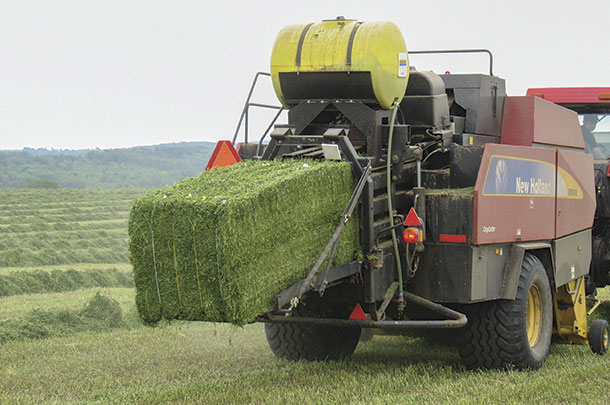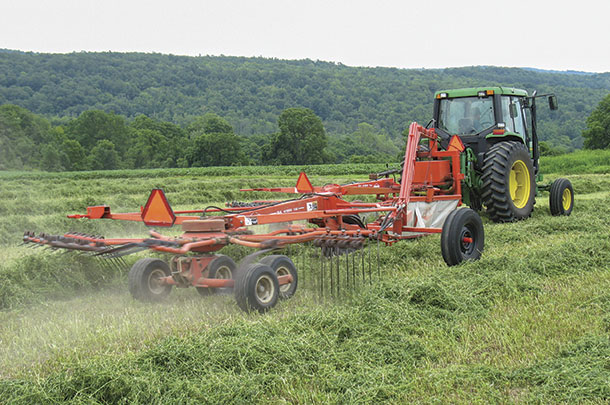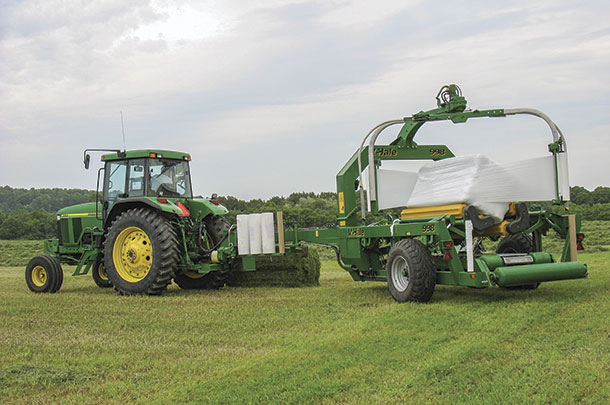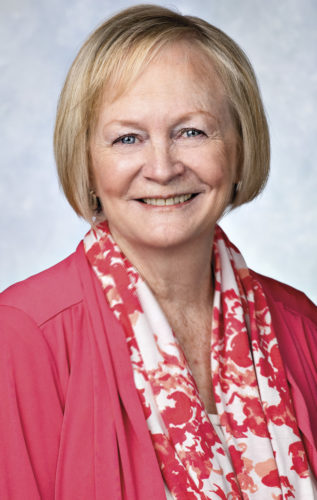Oliver Phelps and Nathaniel Gorham then negotiated with the Seneca and other Iroquois tribes to obtain clear title for the parcel. But Phelps and Gorham were unable to make the second installment – and therefore lost a portion of the purchase and were forced to sell at a discount land that had already been purchased.
In 1798, the Blackmer family from Vermont decided to go West (or what was then thought of as “West”) and purchased a 200-acre farm from the Phelps and Gorham Purchase 300 miles from New York City in wheat country: Livonia, New York. Livonia was propitiously located in the Finger Lakes area, and the lakes were used to power mills to grind wheat into flour.
Carl Blackmer is the seventh generation on the farm today, which has grown to about 800 acres. He also farms an additional 1,200 acres, producing wheat, corn, soybeans and hay – mostly grass hay (timothy) and some alfalfa.
Selling most of the hay to the East Coast horse market, Blackmer found he had two limitations: He couldn’t keep up with the demand, and it seemed no matter what combination of bale size he produced, there were always customers wanting a different-sized bale than what he had on hand.

Blackmer says, “Because I belong to the hay association (National Hay Association), I traveled around, and I saw all the equipment that Steffen (Steffen Systems) builds for doing that type of thing – converting bigs to littles. And that got me to thinking I could do away with all my little balers and just harvest hay in big bales.
Then when people wanted the little bales, I could make them through my Steffen hay press. Now I can make whatever package they need. And I can harvest with the efficiency of big bales and still sell little bales. In 2006, I bought the Steffen hay press. It’s a sized-down, export-type press. I got rid of all my little balers and bale wagons and all that equipment.”

The hay press and bale conversion process allows Blackmer to buy additional hay and keep customers supplied year-round, where before he could only supply a customer for four months. Today, because of that expansion, Blackmer can only produce about one-third of the hay he sells. He purchases an additional 5,000 tons from local sources and Canadian growers.
Fritz Trauttmansdorff, from Dunlea Farms Ltd. in Jerseyville, Ontario, Canada, is one of Blackmer’s hay sources. Trauttmansdorff grows soybeans (for the Japanese tofu market), grain corn, winter wheat and hay – mostly a timothy-alfalfa mix – on 2,000 acres near Toronto.

Like Blackmer, he initially bales in large bale sizes, but his customers in the burgeoning Toronto horse market want smaller bales, so he uses a Steffen rebaler for the conversion. The smaller compressed bales also maximize trucks for weight when shipping, making a 55-pound bale that’s 24 inches long.
Trauttmansdorff says, “When I have the right stuff for Carl, I sell to him, and sometimes I procure hay for him from our area. He’ll tell me what he needs, and I find it for him for the right price and ship it to him. I usually arrange the shipping and hire the trucks.”
Is it difficult to move hay across the American-Canadian border? Trauttmansdorff says, “It’s actually very easy. I’m a pre-approved shipper, but to set it up with a good broker, it’s not very difficult to do. We buy all over North America but mostly within 100 to 200 miles of the farm.”
When Blackmer arranges hay from Canada, he says, “Usually the people I buy it from arrange trucking, and they arrange all the customs. It’s not bad getting hay through customs. If you ship hay to Canada, you have to do a lot more paperwork than you do if you bring hay from Canada to here.”
Rebaling and compressing bales has changed the game for both Blackmer and Trauttmansdorff. Both agree that “we actually have more work in the winter than in the summer.” Because of that, Blackmer can keep full-time employees busy year-round and can create a revenue stream year-round. With those considerations, Blackmer says the rebaler probably paid for itself in the first five years.
And finding customers is apparently the easy part. Blackmer says, “I don’t find customers. Customers find me. All I do is answer my phone. I realize it’s not a good marketing plan, but it works for me. In this area, if you put up a good product, people will find you.”
In the Finger Lakes area, with an average of 35 inches of rainfall a year, lack of water can still be a problem – or, more clearly, lack of timely rainfall.
The 2016 growing season was very dry and knocked a usual two- to four-cutting system back to only one cutting. Blackmer says, “We have a lot of water here with the Finger Lakes, but there’s no infrastructure built for irrigation, and we don’t typically have good enough wells to supply water. You have to have about 1,000 gallons per minute for good irrigation, and our wells are maybe 10 or 20 gallons a minute.”
Technology is another facet of the industry that has changed Blackmer’s operation. He says, “We have GPS and autosteer on almost every piece of equipment. In this area, we put drainage tile in, installed with GPS. GPS is three-dimensional, not just two-dimensional. With GPS, you can hold a grade through hills and holes and whatever with a tile plow. GPS is our biggest technology change.”
Blackmer says family is the backbone of his operation. His wife, Kim; son, Makar; and two grandchildren, Grace and Gavin; each help support the business with two additional full-time employees.
Blackmer says his son doesn’t have an interest in the business side of the operation, with its piles of paperwork, although he is a good hard worker and runs the equipment. Blackmer says, “You can’t hold that against him. And if he doesn’t want to take over the farm, he shouldn’t. We can’t take for granted everybody who farms is going to be a good businessman.” That may leave the future of the business up to the grandchildren. Blackmer says, “I’m hoping my grandchildren … I hope I can live long enough so they can take over the management.” ![]()
PHOTO 1: Tedders move through a hayfield on Old Fort Farm near Livonia, New York
PHOTO 2: Carl Blackmer uses the convenience of baling with a large square baler, then resizes bales through the winter for customers requiring smaller bales.
PHOTO 3: Drying hay for a large square baler in New York can sometimes be a challenge, but Carl Blackmer says the convenience of large square bales is worth the effort.
PHOTO 4: A large square bale is wrapped on Old Fort Farm. Photos provided by Carl Blackmer.

-
Lynn Jaynes
- Editor
- Progressive Dairyman
- Email Lynn Jaynes














